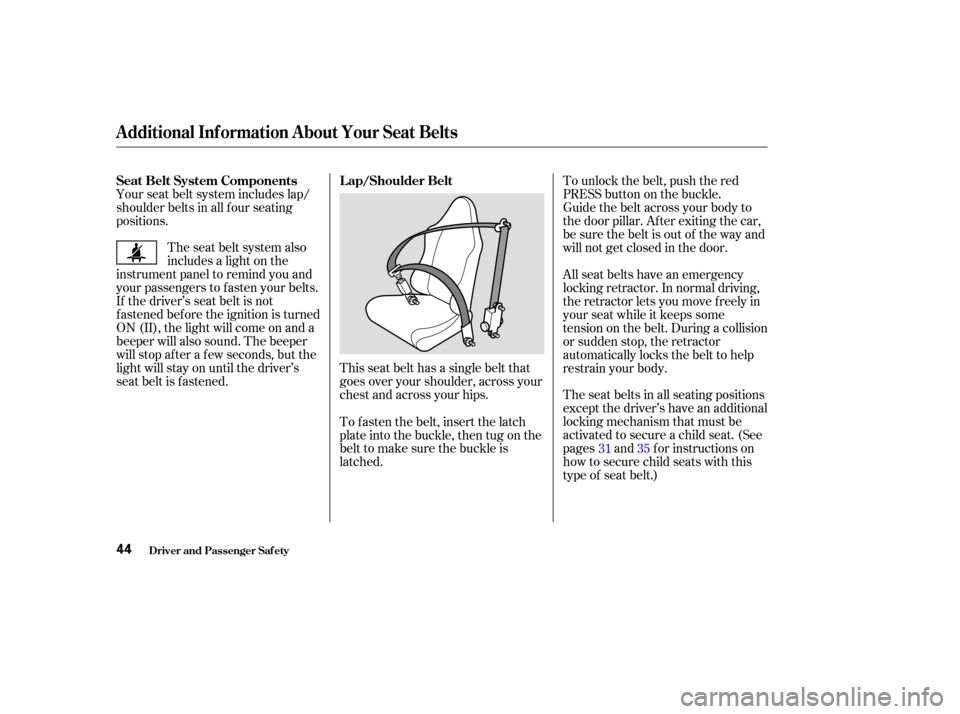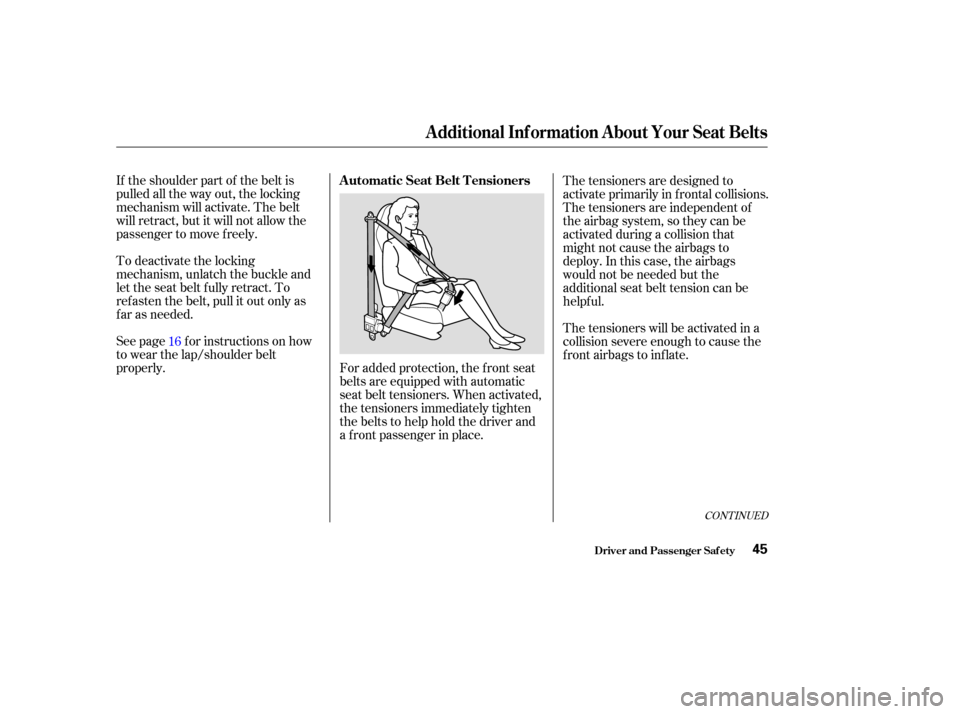Acura RSX 2003 Service Manual
Manufacturer: ACURA, Model Year: 2003, Model line: RSX, Model: Acura RSX 2003Pages: 320, PDF Size: 4.24 MB
Page 41 of 320

Devices intended to improve
occupant comf ort or reposition the
shoulder part of a seat belt, severely
compromise the protective capability
of the seat belt and increase the
chance of serious injury in a crash.
If they do, they could
be very seriously injured in a crash.
To determine if a lap/shoulder belt
properly f its a child, have the child
sit in the rear seat, all the way back
against the seat and put on the seat
belt. Follow the instructions on page .Then check how the belt f its. However, if the shoulder belt
touchesorcrossesthechild’sneck,
or if the lap belt crosses the child’s
stomach, the child needs to use a
booster seat.
This could result in serious neck and
internal injuries during a crash.
This could cause
very serious injuries during a crash.
It also increases the chance that the
child will slide under the belt in a
crash and be injured.
If the shoulder part of the belt rests
over the child’s collarbone and
against the center of the chest, and
the lap belt rests over the child’s
hipbones and touches the tops of their thighs as shown, the child is
probably big enough to wear the seat
belt.
16
Do not put any accessories on a seat belt.
T wo children should never use t hesame seat belt .
Checking Seat Belt Fit
Do not let a child wear a seat beltacross t he neck or over t he st omach.
Do not let a child put the shoulderpart of a seat belt behind t he back orunder t he arm.
Protecting Children
Driver and Passenger Saf ety38
Page 42 of 320

The back seat is the safest place for
a child of any age or size. The National Highway Traffic Safety
Administration and Transport
Canada recommend that all children
ages 12 and under be properly
restrained in a back seat.
In addition, the passenger’s f ront
airbag poses serious risks to children.
If the seat is too f ar f orward, or the
child’s head is thrown f orward
during a collision, or the child is
unrestrained or out of position, an
inf lating f ront airbag can kill or
seriously injure the child.
The side airbag also poses risks. If
any part of a larger child’s body is in
the path of a deploying airbag, the
child could receive possibly serious
injuries.
Whichever style you select, f ollow
the booster seat maker’s instructions. If a child needs a booster seat, we
recommend choosing a high or low-
back style that allows the child to be
directly secured with the lap/
shoulder belt. A child should continue using a
booster seat until the child exceeds
the booster seat manufacturer’s
requirements.
Even then, the child may still need to
use a booster seat. Note that some
states now require children to use
boosters until they reach a certain
ageand/orweight.Besuretocheck
current laws in the state or states
where you intend to drive.
CONT INUED
When Can a Larger Child Sit in Front
Using a Boost er Seat
Protecting Children
Driver and Passenger Saf ety39
Page 43 of 320

Supervise the child. Even mature
children sometimes need to be
reminded to f asten the seat belts
or sit properly.
If you decide that a child can saf ely
ride up f ront, be sure to:
Caref ully read the owner’s manual
and make sure you understand all
seat belt instructions and all saf ety
inf ormation.
Move the vehicle seat to the rear-
most position.
Have the child sit up straight, back
against the seat, and feet on or
near the f loor.
Check that the child’s seat belt is
properly positioned and secured.
Of course, children vary widely. And
while age may be one indicator of
when a child can saf ely ride in the
f ront, there are other important
f actors you should consider.
Physically, a child must be large
enough f or the lap/shoulder belt to
properly f it over the hips, chest, and
shoulder (see pages and ). If
the seat belt does not f it properly,
the child should not sit in the f ront.
To saf ely ride in f ront, a child must
be able to f ollow the rules, including
sitting properly and wearing the seat
belt properly throughout a ride. Remind the child not to lean toward
the door because of the side airbag.
16 38
Physical Size
Maturity
Protecting Children
Driver and Passenger Saf ety40
Page 44 of 320

Since a tether can provide additional
security, we recommend using a
tether whenever one is required or
available.
To use the anchorage point, pivot its
cover down.Attach the tether strap hook to the
tether anchorage point and tighten
the strap according to the child seat
maker’s instructions.Remove the cargo area cover when
you use a tether. See Cargo Area
Cover on page .
Your Acura has two tether
anchorage points on the rear panel
f or securing a tether-style child seat
to the car. 89
Using Child Seats with T ethers
Protecting Children
Driver and Passenger Saf ety41
TETHER ANCHORAGE POINT
COVER
Page 45 of 320

Your car is equipped with LATCH
(Lower Anchors and Tethers f or
Children) at the rear seats. The
lower anchors are located between
the seat-back and seat bottom and
aretobeusedonlywithachildseat
designed f or use with LATCH.
The exact location of each lower
anchorage is marked with a small
circle above the lower anchorage
point.To install a LATCH-compatible child
seat:
Move the seat belt buckle or seat
belt tongue away f rom the lower
anchors.
Make sure there are no f oreign
objects around the anchors.
Foreign objects could get in the
way of a secure connection
between the child seat and the
anchors. Put the child seat in the rear lef t
or right vehicle seat and attach the
child seat to the lower anchors
according to the child seat maker’s
instructions.
1.
2.
3.
Protecting Children
Driver and Passenger Saf ety
Using L A T CH
42
LOWER ANCHORAGES Rigid type
Page 46 of 320

Follow the child seat maker’s
instructions f or any additional
advice on adjusting or tightening
the fit.Attach the attaching clip to the
tether anchor fitting and tighten
the strap according to the child
seat maker’s instructions. Make
sure the strap is not twisted.
Push and pull the child seat
f orward and f rom side to side to
verif y that it is secure enough to
stay upright during normal driving
maneuvers.This symbol on rear or f orward
f acing child seats or booster
cushions indicates the presence of
LATCH compatible hardware.
4.
5.
6.
Protecting Children
Driver and Passenger Saf ety
L ower Universal Anchorage
System Symbol
43
Flexible type
Page 47 of 320

This seat belt has a single belt that
goes over your shoulder, across your
chest and across your hips.
The seat belt system also
includes a light on the
instrument panel to remind you and
your passengers to f asten your belts.
If the driver’s seat belt is not
fastened before the ignition is turned
ON (II), the light will come on and a
beeper will also sound. The beeper
will stop af ter a f ew seconds, but the
light will stay on until the driver’s
seat belt is f astened. The seat belts in all seating positions
except the driver’s have an additional
locking mechanism that must be
activated to secure a child seat. (See
pages and f or instructions on
how to secure child seats with this
type of seat belt.) All seat belts have an emergency
locking retractor. In normal driving,
the retractor lets you move f reely in
your seat while it keeps some
tension on the belt. During a collision
or sudden stop, the retractor
automatically locks the belt to help
restrain your body. Guide the belt across your body to
the door pillar. Af ter exiting the car,
be sure the belt is out of the way and
will not get closed in the door. To unlock the belt, push the red
PRESSbuttononthebuckle.
To fasten the belt, insert the latch
plate into the buckle, then tug on the
belt to make sure the buckle is
latched.
Your seat belt system includes lap/
shoulder belts in all f our seating
positions.
31 35
Seat Belt System Components L ap/Shoulder Belt
Additional Inf ormation About Your Seat Belts
Driver and Passenger Saf ety44
Page 48 of 320

If the shoulder part of the belt is
pulled all the way out, the locking
mechanism will activate. The belt
will retract, but it will not allow the
passenger to move f reely.
To deactivate the locking
mechanism, unlatch the buckle and
let the seat belt f ully retract. To
ref asten the belt, pull it out only as
f ar as needed.
See page f or instructions on how
to wear the lap/shoulder belt
properly.The tensioners are designed to
activate primarily in f rontal collisions.
The tensioners are independent of
the airbag system, so they can be
activated during a collision that
might not cause the airbags to
deploy. In this case, the airbags
would not be needed but the
additional seat belt tension can be
helpf ul.
The tensioners will be activated in a
collision severe enough to cause the
f ront airbags to inf late.
For added protection, the f ront seat
belts are equipped with automatic
seat belt tensioners. When activated,
the tensioners immediately tighten
the belts to help hold the driver and
a f ront passenger in place.
16
CONT INUED
A utomatic Seat Belt T ensioners
Additional Inf ormation About Your Seat Belts
Driver and Passenger Saf ety45
Page 49 of 320

For saf ety, you should check the
condition of your seat belts regularly.
Pull each belt out f ully and look f or
f rays, cuts, burns, and wear. Check
that the latches work smoothly and
that the lap/shoulder belts retract
easily. Any belt not in good condition
or not working properly will not
provide good protection and should
be replaced as soon as possible.
When the tensioners are activated,
the seat belts will remain tight until
they are unbuckled in the normal
way.
The SRS indicator light will
come on if there is a
problem with your automatic seat
belt tensioners (see page ).
Acura provides a lif etime warranty
on seat belts. Acura will repair or
replace any seat belt component that
f ails to f unction properly during
normal use. Please see yourbooklet f or
details.
51
Acura
Warranty Inf ormation
Seat Belt Maintenance
U.S. Models
Additional Inf ormation About Your Seat Belts
Driver and Passenger Saf ety46
Not checking or maintaining
seat belts can result in serious
injury or death if the seat belts
do not work properly when
needed.
Check your seat belts regularly
and have any problem
corrected as soon as possible.
Page 50 of 320

If a seat belt is worn during a crash,
it must be replaced by the dealer. A
belt that has been worn during a
crash may not provide the same level
of protection in a subsequent crash.
The dealer should also inspect the
anchors f or damage and replace
them if needed.
Automatic seat belt tensioners that
deployed during a crash must be
replaced.
For inf ormation on how to clean your
seat belts, see page .257
Additional Inf ormation About Your Seat Belts
Driver and Passenger Saf ety47